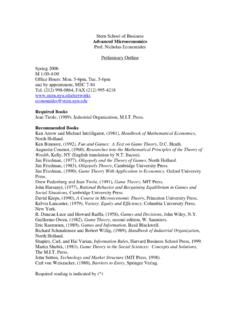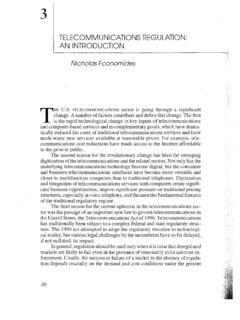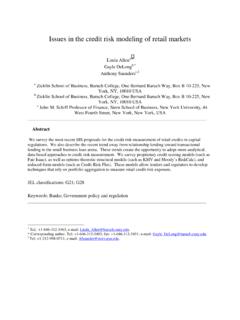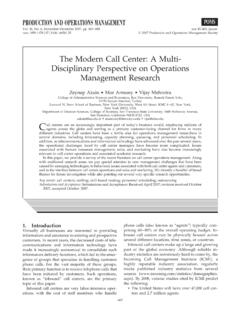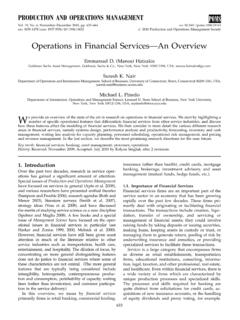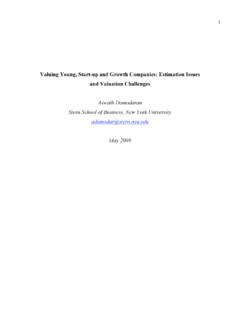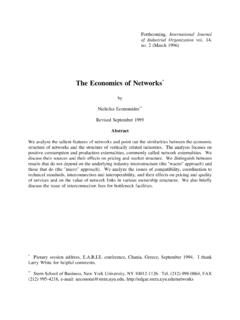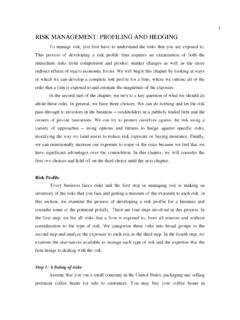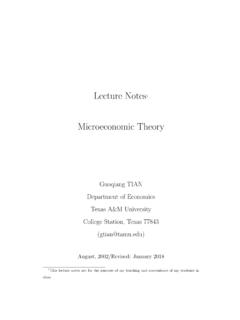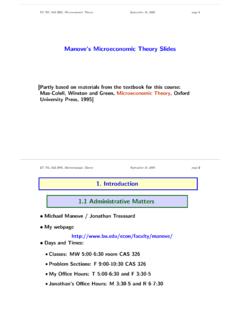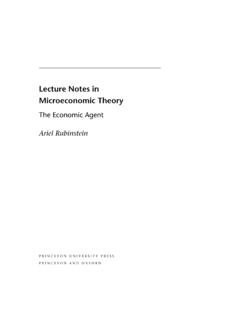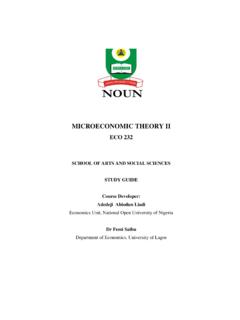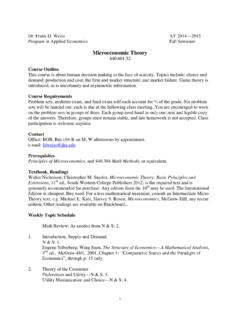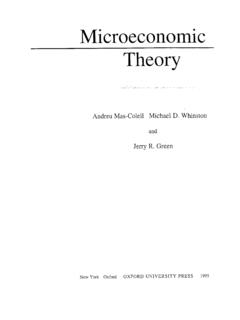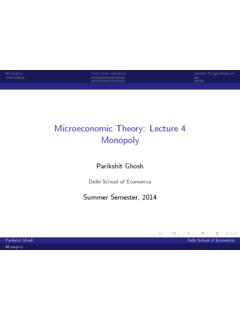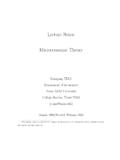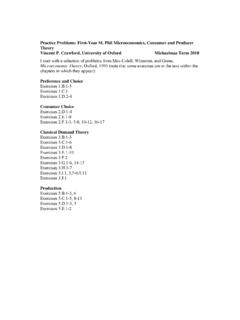Transcription of NOTES FOR MICROECONOMICS 2011
1 NOTES FOR MICROECONOMICS by Prof. Nicholas Economides Stern School of Business Spring 2015 Copyright Nicholas Economides 1 MICROECONOMICS is about 1. Buying decisions of the individual 2. Buying and selling decisions of the firm 3. The determination of prices and in markets 4. The quantity, quality and variety of products 5. Profits 6. Consumers satisfaction There are two sides in a market for a good DEMAND SUPPLY Created by Consumers Created by firms Each consumer maximizes Each firm maximizes its satisfaction ( utility ) profits ------------------------------- ------------------------------ CONSUMPTION THEORY PRODUCTION THEORY 2We will first study consumption and later production.
2 In the third part of the course we will take the demand schedule from the consumption analysis and the supply schedule from the production analysis and put them together in a market. The price, and the quantity exchanged will be determined in the market. We will also discuss the performance and efficiency of markets. A. CONSUMPTION ANALYSIS UNDER CERTAINTY 1. Goods are products or services that consumers or businesses desire. Examples: a book, a telephone call, insurance coverage. Goods may be directly desired by consumers or may contribute to the production of other goods that are desired by consumers. For example a machine used in the production of cars is desirable because it is useful in the production of cars, although it has no direct value to a consumer.
3 Bads are products or services that consumers desire less of. Examples: garbage, pollution, some telephone calls. Clearly, a good for one consumer could be a bad for another. 2. If possible, each consumer would consume a very large (infinite) amount of each good. But, each individual is constrained by his/her ability to pay for these goods. The limitation of total funds available to an individual defines the 3budget constraint. Therefore a consumer has to maximize his/her satisfaction while not spending more than he/she has, , without violating the budget constraint. 3. We are interested to find the best choice for a consumer that has a limited amount of funds. We accomplish this in three steps.
4 At the first step, we define the available choices taking into account the limitation of funds. At the second step, we discuss the desires/wants of the consumer. At the third step, we find the optimal choice for the consumer by putting together the information we gathered in the previous two steps. STEP 1: We first analyze the available choices to a consumer that possesses limited funds. Suppose there are only two goods, X and Y, and they are sold at prices px and py per unit respectively. If a consumer buys x units of good X and y units of good Y, she spends xpx on good X, and ypy on good Y. Total expenditure is E = xpx + ypy. The pair (x, y) is called a (consumption) basket or (consumption) bundle.
5 If the consumer has a total amount of money I (income) her total expenditure cannot exceed I, , 4xpx + ypy I. This is called the budget constraint. The set of available (x, y) combinations is called the budget set. See Figure 1. Figure 1 For example, X is apples sold at $1 per pound, Y is oranges sold at $ each, and the consumer has I = $3 to spend. Then the basket (1, 4) ( , 1 pound of apples and 4 oranges) costs 1 + 4(.5) = $3, and therefore is in the budget set. 5 Note that since basket (1, 4) available to the consumer, so are baskets where she buys less of each or less of both of the goods, such as (0, 4), (1, 3), (1, 2), etc., since they cost less. 4. The budget constraint can be represented in the X-Y space.
6 There are two cases, either the consumer spends all her income and xpx + ypy= I, or the consumer has some left-over income and xpx + ypy < I. We are primarily interested in the case where all income is spent. Note that and xpx + ypy = I is a straight line in the X-Y space. It is called the budget line. Its slope is -px/py. If the consumer spends all the money in good X then she buys I/px units of this good. This is the maximum amount of X that she can buy. It defines the most extreme point of the triangle on the X-axis. If all money is spend on good Y, it will buy I/py units of good Y. This is the most extreme point of the triangle on the y-axis. All bundles (x, y) where the consumer does not exhaust all income are below the budget line.
7 The budget set contains all the points in the shaded triangle, including its boundary lines. STEP 2: We now describe the preferences of the consumers. 5. In a comparison of any two bundles, A = (xA, yA) and B = (xB, yB), an 6individual should be able to say either (i) I prefer A to B ; or (ii) I prefer B to A ; or (iii) I am indifferent between A and B , , I like equally A and B . This property of preferences is called completeness. Essentially the consumer is not allowed to say I don t know or I am not sure. The second property of preferences is transitivity. If a person states, I prefer A to B, as well as I prefer B to C, then he/she also has to prefer A to C.
8 This assumption says that preferences are consistent, so that comparisons between bundles A and C are consistent with comparisons between bundles A and B and between B and C. Transitivity in indifference means that a person who says, I am indifferent between A and B, as well as I am indifferent between B and C, also has to be indifferent between A and C. The third assumption on preferences is that more is better . 6. Since more is better , if bundle A = (xA, yA) has more of both goods than bundle B = (xB, yB), , if xA > xB and yA > yB, then clearly a consumer will prefer A to B. Similarly if bundle A has less of both goods than bundle B, then 7a consumer will prefer B to A.
9 However, if bundle A has more of X but less of Y than B, the comparison is not obvious. The consumer may prefer A to B, or prefer B to A, or be indifferent between A and B. One can create a collection of all the bundles, A, B, C, D, .., such that a particular consumer is indifferent between any two of them. The line in X-Y space that connects the points in this collection {A, B, C, D, ..} is called an indifference curve, I1 (Figure 2). Of course, the same consumer typically has many indifference curves. For example, he has both A-B-C-D and E-F-G-H as indifference curves, and he prefers any bundle on E-F-G-H to any on A-B-C-D. In general, there is an indifference curve through any point in X-Y space.
10 Since more is better, an indifference curve cannot have a positive slope. Indifference curves have a negative slope, and in special cases zero slope. An indifference curve defines the substitution between goods X and Y that is acceptable in the mind of the consumer. As we move towards the Southeast along a typical indifference curve the consumer receives more X and less Y, while she declares that she is equally well off. 8 Figure 2 7. Typically indifference curves are convex. This means that starting with two bundles, A, B, which the consumer the consumer likes equally and are therefore on the same indifference curve, she prefers C, the average of two extreme bundles, rather than either of them.
